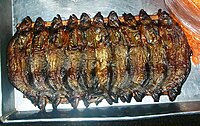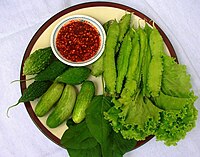Diagnostic Description
provided by Fishbase
Distinguishable by its plain brown adult coloration and the convex or only slightly concave dorsal head profile; juveniles (
- Recorder
- Crispina B. Binohlan
Diseases and Parasites
provided by Fishbase
Fish louse Infestation 1. Parasitic infestations (protozoa, worms, etc.)
Diseases and Parasites
provided by Fishbase
Procamallanus Infection 5. Parasitic infestations (protozoa, worms, etc.)
Diseases and Parasites
provided by Fishbase
Pleurogenoides Infestation. Parasitic infestations (protozoa, worms, etc.)
Life Cycle
provided by Fishbase
Spawning occurs at night (Ref. 1672).
Migration
provided by Fishbase
Potamodromous. Migrating within streams, migratory in rivers, e.g. Saliminus, Moxostoma, Labeo. Migrations should be cyclical and predictable and cover more than 100 km.
Morphology
provided by Fishbase
Dorsal soft rays (total): 7 - 9; Analsoft rays: 97 - 111
- Recorder
- Crispina B. Binohlan
Trophic Strategy
provided by Fishbase
Found in clear streams and enters brackish waters (Ref. 4832). Inhabits standing and sluggish waters of lakes, floodplains, canals and ponds (Ref. 12693). Recorded as having been or being farmed in rice fields (Ref. 119549). Undertakes localized lateral migrations from the Mekong River to floodplains during the flood season and back to the mainstream or other permanent water bodies during the dry season (Ref. 37770). Common in tanks throughout the greater parts of India. Feeds on insects, fish (Ref. 12693), crustaceans and some young roots of aquatic plants (Ref. 6459).
Biology
provided by Fishbase
Found in clear streams and enters brackish waters (Ref. 4832). Adults inhabit standing and sluggish waters of lakes, floodplains, canals and ponds (Ref. 12693). Undertake localized lateral migrations from the Mekong River to floodplains during the flood season and back to the mainstream or other permanent water bodies during the dry season (Ref. 37770). Common in tanks throughout the greater parts of India. Feed on insects, fish (Ref. 12693), crustaceans and some young roots of aquatic plants (Ref. 6459). Active during twilight and night. Colonize and breed seasonally during rainy days and migrates back to permanent waters in dry season (Ref. 12693). Breeding takes place in stagnant or running waters in the rainy season. Eggs are laid in small clumps on submerged vegetation. A female measuring 21-25 cm usually lays 1,200-3,000 eggs. The fish is relished both in fresh and dried state. Soup made from it is reported to be given to people with measles (Ref. 7431). Of high economic importance as food fish in South and Southeast Asia to Borneo and Sumatra and taken by all types of small-scale fishing gears (Ref. 57235).
Importance
provided by Fishbase
fisheries: commercial; aquaculture: commercial; aquarium: commercial
Bronze featherback
provided by wikipedia EN
The bronze featherback (Notopterus notopterus; Assamese: কান্ধুলি kandhuli, Bengali: ফলি,Bengali: কাংলা,, Thai: ปลาสลาด, ปลาฉลาด, ปลาตอง, Vietnamese: Cá thát lát, Burmese: ငါးဖယ်) is a ray-finned fish in the family Notopteridae found in South and Southeast Asia. Although primarily found in fresh water, it has been known to enter brackish water.[2] At present, it is the only member of the genus Notopterus,[3] but as currently defined, it is likely a species complex.[1]
Description
Young specimens are a dark bronze-like color that becomes lighter with age. The species reaches a length up to 60 cm (24 in).[2]
The bronze featherback can easily be kept in an aquarium. Popular as food, this fish also appears in a stamp of the Kingdom of Laos.[4]
As food
This fish has been used as food in Southeast Asia since ancient times,[5] and remains an important food item in countries such as Indonesia, Laos, Myanmar (Burma), and Thailand. It is preserved and prepared in different ways.
In Burmese cuisine, the flesh of the bronze featherback, locally known as ngaphe, is used in ngachin, a pressed fish pickle, and is used to make fish paste.[6]
In Thai cuisine, nam phrik pla salat pon (น้ำพริกปลาสลาดป่น) is a variety of nam phrik with minced roasted pla salat eaten along with raw vegetables. It is popular in Khorat.[7] Although much smaller in size, it is similar in appearance to the Chitala ornata, another important fish in Thai cuisine.

Dried and smoked
Pla salat, a
Khorat specialty
See also
References

- license
- cc-by-sa-3.0
- copyright
- Wikipedia authors and editors
Bronze featherback: Brief Summary
provided by wikipedia EN
The bronze featherback (Notopterus notopterus; Assamese: কান্ধুলি kandhuli, Bengali: ফলি,Bengali: কাংলা,, Thai: ปลาสลาด, ปลาฉลาด, ปลาตอง, Vietnamese: Cá thát lát, Burmese: ငါးဖယ်) is a ray-finned fish in the family Notopteridae found in South and Southeast Asia. Although primarily found in fresh water, it has been known to enter brackish water. At present, it is the only member of the genus Notopterus, but as currently defined, it is likely a species complex.
- license
- cc-by-sa-3.0
- copyright
- Wikipedia authors and editors



